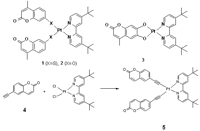Inorganic Chemistry, University of Konstanz, Universitätsstraße 10, 78464 Konstanz, Germany
e-mail: matthias.rank@uni-konstanz.de

| Matthias Rank and Rainer F. Winter
Inorganic Chemistry, University of Konstanz, Universitätsstraße 10, 78464 Konstanz, Germany e-mail: matthias.rank@uni-konstanz.de |
 |
Square-planar platinum complexes of the type (diimine)Pt(ER)2 (E = O, S) are an important class of sensitizers for the conversion of light into chemical or electrical energy.[1] The basic idea of this work is to improve the efficiency of such sensitizers utilizing dye-functionalized donor ligands. The new square-planar platinum complexes 1, 2 and 3 with coumarins as "dye ligands" were prepared and their (spectro-)electrochemical properties were investigated.
UV/vis-spectroscopy and luminescence measurements showed that the luminescent 3MLCT-state is generated by irritation into the (ML)-L' CT-band of the complex as well as by irradiation into the π-π*-absorption band of the dye. This allows for a more efficient use of near UV/visible light for generating the charge separated state of the complexes.[2] Experimental results are backed by quantum chemical calculations. The new coumarin dye 4 could also be synthesized and connected to a Pt-diimine moiety. Complex 5 shows improved absorbance and quantum yields.